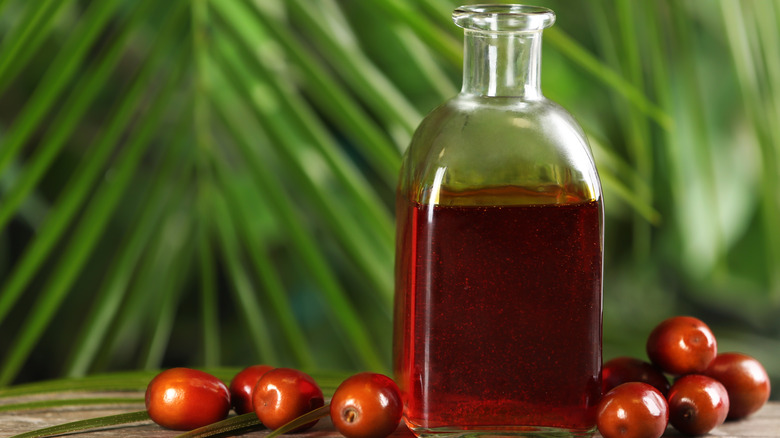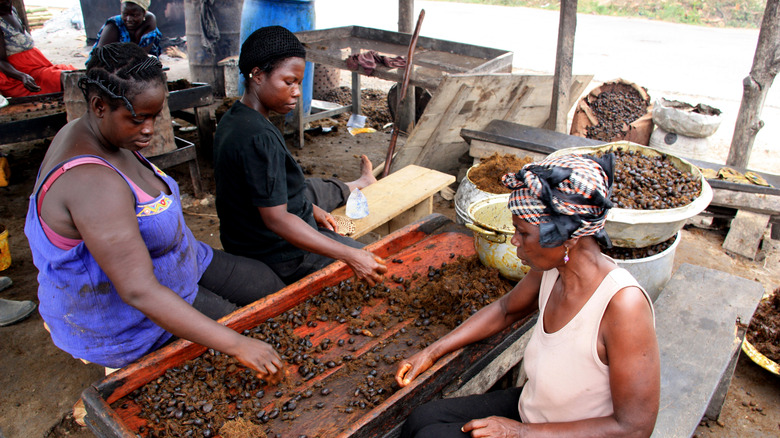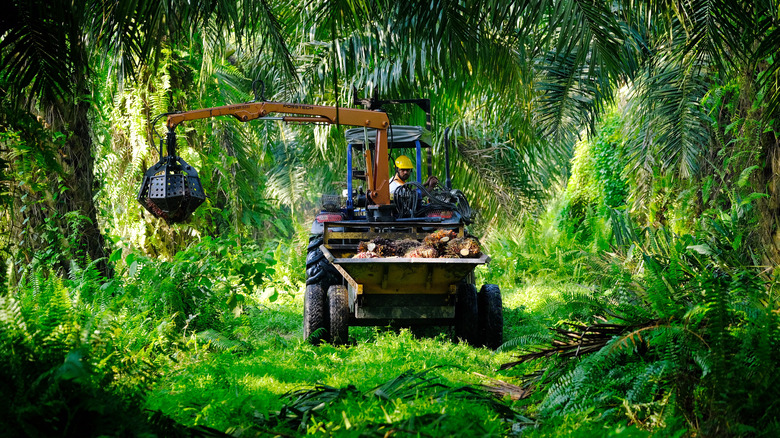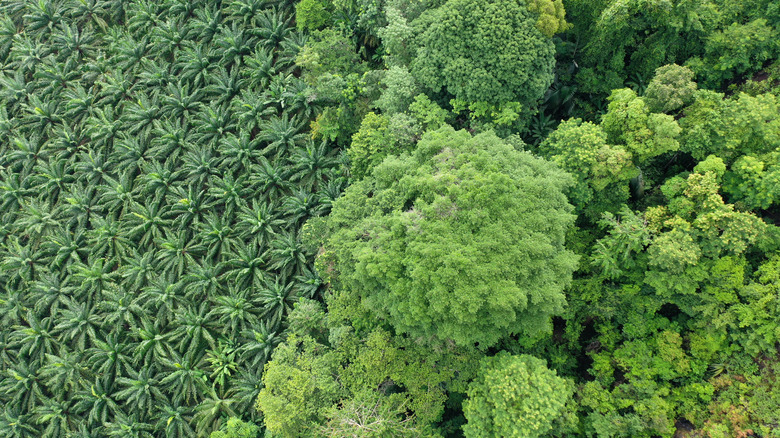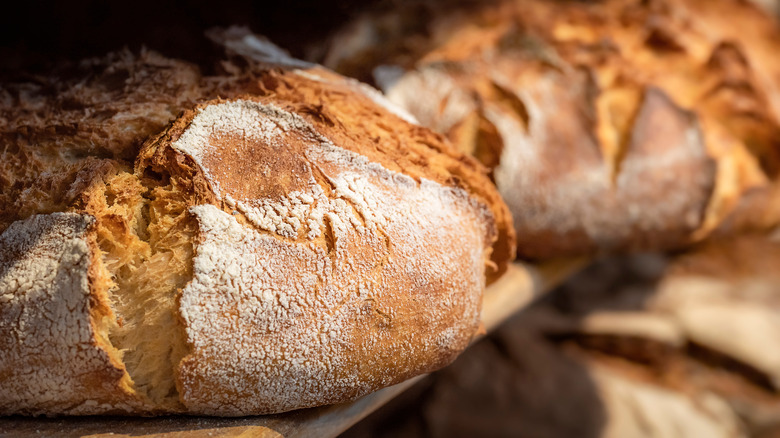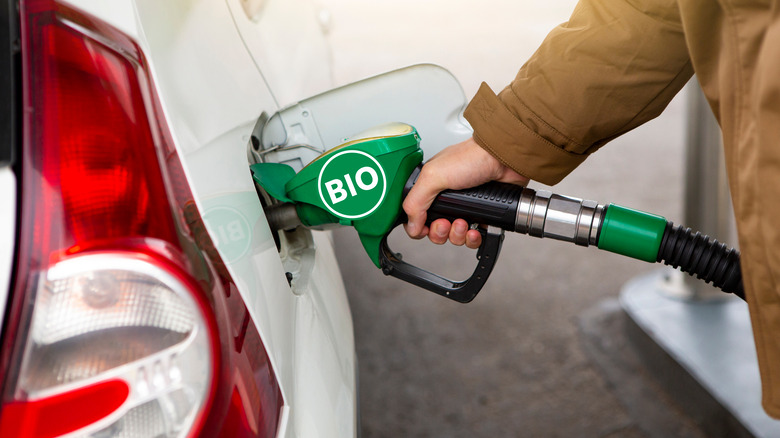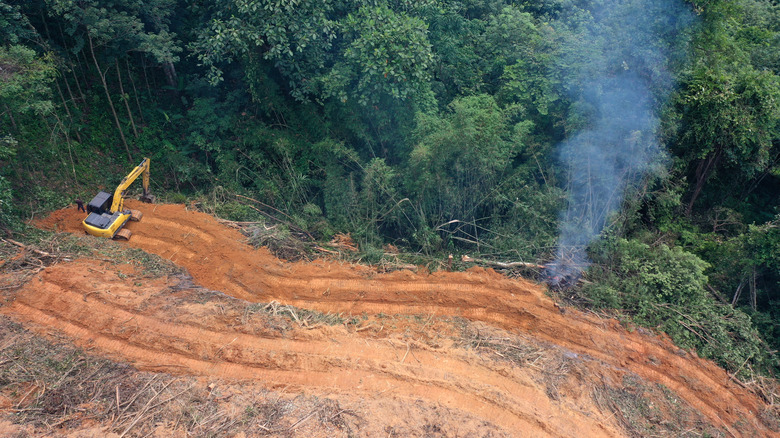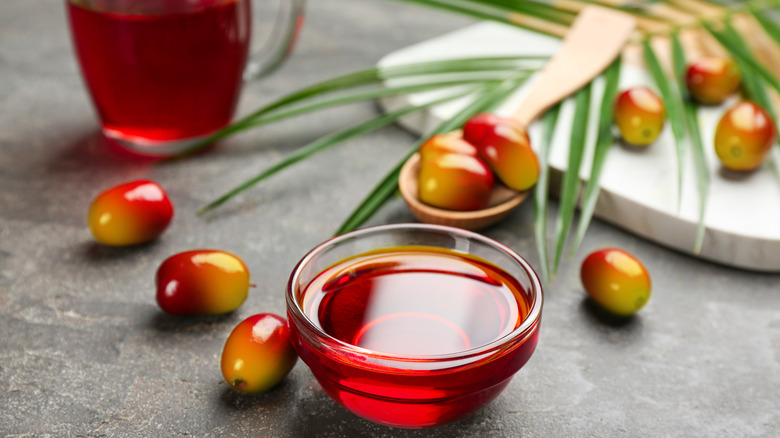The Untold Truth Of Palm Oil
From baked goods to toothpaste, palm oil is an ingredient in a huge number of everyday staples. In fact, each of us consumes around eight kilograms of palm oil a year (via Guardian). Grown on oil palm trees, palm oil comes in two varieties. The first one is extracted from the mesocarp or pulp that sits between the seed or kernel and the outer skin of the fruit. And the second is from the fruit's kernel. While the former is commonly used in edibles, the latter makes frequent appearances in products such as cosmetics, soaps, and candles. Palm oil is also often used to make biofuels (via Report Linker).
There's a good reason why palm oil is such a popular commodity. The crop is cheap and efficient to grow — the tall, leafy plants need around one-ninth of the land required by some other oil-producing crops to cultivate the same amount of vegetable oil (via Mongabay News). The news isn't all good, however. Despite its effectiveness, palm oil has attracted its fair share of controversy, with the contentious plant blamed for deforestation, loss of biodiversity, and increased CO2 emissions. Keep reading to find out more about this ubiquitous ingredient.
Palm oil originated in West Africa
Palm fruit, kernels, and oil were already a part of the West African diet around 5,000 years ago. Indigenous to the area, the crop became popular in Western and Central Africa after a prolonged dry period some 2,500 years ago when it was grown in semi-wild groves. Today, palm oil is still used in West African cuisine and is a key element of Nigeria's Yoruba culture. "When a couple is about to get married, [their loved ones] bless them with palm oil and they say, may their life be as sweet as the palm oil is," Simi Adebajo, the head chef and owner of San Francisco catering business Eko Kitchen told Eater.
The palm oil boom in Europe started with the slave trade in the 16th century when the crop was used to feed enslaved African people while in transit on ships. Later, palm oil started being used to lubricate machinery and make soap. After the African slave trade was made illegal in 1807, Europeans continued to transport palm oil as a product. In fact, when European countries divided Africa at the Berlin Conference of 1884, England ended up with colonial powers over Nigeria, partly due to the influence of a British palm oil estate owner George Goldie who had been transporting the commodity from West Africa.
Most of the world's palm oil is harvested in Indonesia and Malaysia
While Nigeria remains a substantial producer of palm oil, today most of the crop is harvested in Indonesia and Malaysia. In fact, the two Southeast Asian countries make up 84% of the world's palm oil production (via Green Palm). This isn't surprising since the optimal growing conditions for palm oil are the tropical climates within 10 degrees of the equator. And West Africa stopped being an appealing producer option in the 1960s due to the region's deteriorating political situation.
Palm oil is not indigenous to Southeast Asia. Rather, it was first brought to the region as an ornamental plant in the 19th century. The story is that Dutch botanists planted some of the first palm oil seedlings at the botanical gardens in Bogor just outside Indonesia's capital Jakarta. Impressed with how well the plants adapted to the Southeast Asian climate, Belgian entrepreneur Adrien Hallet founded Indonesia's first palm oil plantation at Poeloe Radja in Sumatra in 1911. He then helped to establish Malaysia's first commercial plantation in Selangor in 1917. In 1936, Sumatra alone had eclipsed Nigeria in palm oil exports. By 1939, there were more than 100,000 hectares of estates in Malaysia and Indonesia (via China Dialogue).
Palm oil is an extremely efficient crop
Out of the world's four main oil crops — the other three include sunflower oil, canola oil, and soybean oil — palm oil is by far the most efficient. Around 40% of the world's palm oil is grown on just 6% of the land used to cultivate all other vegetable oils (via CSPO). According to The Conversation, over 50 million additional hectares of land would be required if other oil crops were to replace the edible oil produced by palm trees.
More specifically, a single palm tree can produce approximately 40 kilograms of palm oil annually, with one hectare of the crop producing around 3.8 tons of palm oil every year — this is seven times more than canola oil plants, 10 times more than sunflower oil plants, and 11 times more than soybean oil plants (via Palm Oil Alliance). In addition, palm oil trees have a 25-year life cycle and are a perennial crop that produces fruit all year long.
Palm oil is popular for cooking
Not all oils — or cooking fats — are created equal. Some fats, such as olive oil, are great when consumed cold as a part of salad dressings while others perform better as cooking oils. Palm oil has a rich and creamy texture and no smell, which makes it a favorite ingredient in grilling, frying, sautéing, and baking. Palm oil is also rich in vitamin E tocotrienols, an antioxidant credited with delaying the aging process. Plus, red palm oil retains its vitamin E content even after it's been used for frying three times when other oils lose their vitamin content after a single use. On the downside, palm oil is relatively high in saturated fats, a substance that has been linked with heart disease (via WebMD).
Some oils release toxic chemicals when heated above a certain temperature. Since saturated fats are more stable when heated and palm oil is composed of around 50% saturated fat, it's extremely heat resistant, which makes it great for cooking. Palm oil has a smoke point of 450 degrees Fahrenheit compared to 380 degrees Fahrenheit for olive oil and 400 degrees Fahrenheit for canola oil (via Palm Oil Health). In addition, palm oil acts as a natural preservative for both edibles and other products, allowing food products to retain both their flavor and texture for longer.
Around half of the goods purchased in the U.S. contain palm oil
From ready-to-eat foods to cosmetics or even glue, around 50% of the goods sold in the U.S. contain palm oil. The ingredient is commonly used in lipsticks since it's tasteless and has a high melting point and smooth application. It's also often used to pre-cook instant noodles, and to give a creamy texture to both ice cream and cookies. Margarine is also packed with palm oil due to the fact that the ingredient solidifies at room temperature and contains no trans fats. Away from edibles, palm oil can be found in shampoos, detergents, soaps, and washing powders (via World Wildlife Fund).
Telling whether a product contains palm oil can be a tall order since its derivatives are often listed under a plethora of names, such as glyceryl stearate, Elaeis guineensis, or stearic acid. And while palm oil is ubiquitous on supermarket shelves, only around 10% of products that contain it feature the words "palm oil" clearly marked on the label (via Guardian).
Palm oil is used in the biofuel industry
Biofuels, or fuels made from plant products, were once considered an eco-friendly alternative to diesel and petrol. In 2003, the E.U. mandated that biofuels would have to make up 10% of all fuel used for transport by 2020. However, things didn't work out according to plan. A 2015 report found that greenhouse emissions caused by palm oil-related deforestation were three times higher than the CO2 emissions they replaced. Not surprisingly, the E.U. has now taken steps to reduce imports of palm oil used to make biofuels. (via China Dialogue).
Today, only a tiny percentage of palm oil is used for biofuel production in Western countries, with most of it added to food products and cosmetics. More specifically, only around 5% of the palm oil imported into the E.U. was utilized as an energy source for electricity, heat, and biodiesel in 2016. The U.S. uses corn and soybeans, rather than palm oil, to produce biodiesel (via BMC). Unfortunately, while the E.U is working to reduce palm oil biofuels, some Asian countries such as Indonesia and Malaysia are actually moving to increase their use of biodiesel.
Palm oil is one of the leading causes of deforestation and biodiversity loss
According to Rainforest Rescue, palm oil plantations cover over 27 million hectares of land across the globe. And each year, more and more tropical rainforests are being decimated to make room for palm oil plantations. It's been estimated that an area the size of 300 football fields is cleared each hour to make way for palm oil estates. According to satellite data released by Global Forest Watch, the size of humid primary forest decreased by 10% in Indonesia and 17% in Malaysia between 2002 and 2020 due to forest clearing (via Bloomberg).
The relentless deforestation has had a devastating effect on wildlife, destroying the habitat of endangered species such as Sumatran rhinos and orangutans. A 2020 study found that Bornean Orangutans lost over one-third of their habitat due to land clearing from 1973 to 2015. In addition, palm oil-related deforestation is currently a threat to around 200 at-risk animal species (via Union for the Conservation of Nature).
Palm oil also contributes to greenhouse gas emissions and global warming through the processing and transportation of the product. According to the International Council on Clean Transportation, palm oil plantations contribute to the release of around 500 million tons of carbon dioxide each year — this is 1.4% of the world's net CO2 emissions (via Bloomberg). This is partly because peatlands, which contain 10 times the carbon of mineral soil, are burned to make way for plantations, releasing huge amounts of CO2 into the atmosphere (via The Great Projects).
Demand for palm oil is on the rise
Palm oil is widely used in edibles, cosmetics, and other products, and the demand for the crop is not showing any signs of slowing down. In 2020, more than 73 million tons of palm oil were consumed worldwide. And the demand for the crop is projected to quadruple by 2050 reaching around 250 to 300 million tons (via Eater). Likewise, the global palm oil market is expected to grow from $42.8 billion in 2020 to $57.2 billion by 2026.
The global need for palm oil has been growing steadily along with globalization. In the U.S. and Europe, palm oil imports started increasing dramatically after the regulators began banning unhealthy trans fats from edible goods. Between 1995 and 2015 alone, the yearly production of palm oil increased four-fold from 15.2 million tons to 62.6 million tons (via Guardian). In the U.S., palm oil imports increased almost tenfold from 2000 to 2020, with the country making up 26.98% of the world's palm oil market share in 2021.
Certified sustainable palm oil products are better for the planet
While palm oil is blamed for deforestation and loss of biodiversity in Southeast Asia, boycotting the product is unlikely to be an answer to the problem. In Malaysia and Indonesia, around 4.5 million people make a living from palm oil. And since palm oil is such an effective crop, replacing it with another product would require even more land, which would mean even more logging and burning of peatland.
Luckily, the rise of sustainable palm oil production in the past 15 years is leading to a shift in the production methods within the industry. The movement has been spurred by governments and organizations such as the Roundtable on Sustainable Palm Oil (RSPO), which has set standards to improve sustainability across the industry. Companies within the palm oil production chain that adhere to these standards receive the Certified Sustainable Palm Oil (CSPO) accreditation. Set up in 2004, today RSPO has over 4,000 members, with 20% of the palm oil cultivated in 2020 classified as CSPO (via The Conversation).
